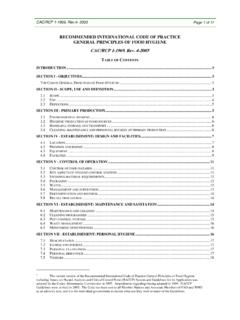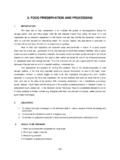Transcription of Flow chart of the production chain of palm oil and palm ...
1 Flow chart of the production chain of palm oil and palm kernel oil products for feed application in the EU (1) Cultivation of palm fruits (A) Transport to the oil mill Palm fruits (2) production of crude oil Processing of fruit bunches Drying and processing of palm kernels Palm kernels Storage and transport Crude oil (B) Transport Storage (D) Transport by ocean going vessel Refining production of RBD oil Fractionation (B) Transport RBD oil RBD oil RBD fractions (C) Storage OUTSIDE EU INSIDE EU Characters between brackets refer to those on the following sheets (3) Refining ( ) production of refined oil ( ) production of fatty acid distillates ( ) production of deodistillates ( ) production of acid oils Refined oil Fatty acid distillates Acid oils Fractionating Fractionated palm oil products (B) Transport (B) Transport (B) Transport Blending (C) Storage EU FEED INDUSTRY Deodistillates (Semi batch refining) (4) Splitting Fatty acids from splitting Glycerine Pitch (B) Transport 90 EFISC Code Sector reference document on the manufacturing of safe feed materials from oilseed crushing and vegetable oil refining 91 EFISC Code Sector reference document on the manufacturing of safe feed materials from oilseed crushing and vegetable oil refining Feed Risk assessment of the chain of palm and palm kernel oil products 1.
2 Cultivation of palm fruits* HAZARD CAT. CHANCE SERIOUSNESS* RISK CLASS. JUSTIFICATION LEGISLATION, INDUSTRY STANDARDS AND/OR CONTRACT TERMS CONTROL MEASURE REMARKS Pesticide residues above the MRL, residues of herbicides, insecticides, fungicides or rodenticides above the MRL. C The countries of export of palm oil (Indonesia, Malaysia and others such as South America and Africa) work with positive lists for the use of pesticides during cultivation which, for some substances, may conflict with European pesticide residue legislation. Hitherto no residues of pesticides have been detected in palm and palm kernel oil. EC Regulation 396/2005 prohibits putting into circulation commodities that do not comply with the MRLs set in the annexes. EC Regulation No. 178/2006 establishes Annex I lists the food and feed products for which pesticide residue limits apply.
3 Regulation 149/2008 establishes Annexes II, III and IV that sets the MRLs for the products listed in Annex I. * Assessment of risks outside the EU is out of the scope of this document. See Methodology document, paragraph for more information. 92 EFISC Code Sector reference document on the manufacturing of safe feed materials from oilseed crushing and vegetable oil refining Feed Risk assessment of the chain of palm and palm kernel oil products 2. production of crude palm oil and crude palm kernel oil* HAZARD CAT. CHANCE SERIOUSNESS RISK CLASS. JUSTIFICATION LEGISLATION, INDUSTRY STANDARDS AND/OR CONTRACT TERMS CONTROL MEASURE REMARKS Boiler chemicals C Increased risk at plants without good manufacturing practices. Steam (using boiler chemicals) that directly comes into contact with the product must be suitable for use in the food industry.
4 Pesticide residues above the MRL, residues of herbicides, insecticides, fungicides or rodenticides above the MRL. C Regular monitoring of pesticide residues shows that these residues seldom occur in crude palm oil and if present are always within legal limits. Regulation 396/2005 sets limits for residues of pesticides. This regulation allows using a processing/concentration factor for pesticides into processed products, providing food safety is assured. The FEDIOL position (11 SAF181) concludes that based on the average oil content in palm fruits, ranging from 50%-55%, and in palm kernels, of 45 %, processing factors of 2 should be used to establish the MRL in palm oil and palm kernel oil. Pesticides residues as listed in EU Directive 2002/32 for undesirable substances in feeding stuff C Some of the banned pesticides may be present in the environment.
5 The chance of finding them in crude palm or palm kernel oil, however, is very low. Directive 2002/32/EC sets limits for a number of pesticides residues in feeding stuff. Recycling of contaminated fat from fat traps in effluent water. C Effluent water may be chemically contaminated. Fat from fat traps in effluent water must not be recycled for food application. Hydraulic oil or lubricants from equipment C Hydraulic oils and lubricants may contain toxic compounds. The prerequisite programme should assure that the contamination of the product with non-food grade hydraulic oils or lubricants is avoided and that the risk of contamination of the product with food grade hydraulic oils and lubricants is minimised. The prerequisite programme could involve recording of the quantities used. The Dutch GMP-limit for C (10-40) in oils is 400 mg/kg.
6 Foreign bodies P Foreign bodies may be present. A system should be in place that removes any foreign material. 93 EFISC Code Sector reference document on the manufacturing of safe feed materials from oilseed crushing and vegetable oil refining Feed Risk assessment of the chain of palm and palm kernel oil products * Assessment of risks outside the EU is out of the scope of this document. See Methodology document, paragraph for more information. Utilities: palm and palm kernel oil refining and processing HAZARD CAT. CHANCE SERIOUSNESS RISK CLASS. JUSTIFICATION LEGISLATION, INDUSTRY STANDARDS AND/OR CONTRACT TERMS CONTROL MEASURE REMARKS Hydraulic oils or lubricants from equipment C Low High 3 Hydraulic oils and lubricants may contain toxic compounds. The prerequisite programme should assure that the contamination of product with non-food grade hydraulic oils or lubricants is avoided and that the risk of contamination of the product with food grade hydraulic oils and lubricants is minimised.
7 The prerequisite programme could involve recording of the quantities used. Contaminants in water such as PFOS and PFOA C Low Medium 2 Water is used in the crushing and refining process. For manufacture of feed, according to Regulation 183/2005/EC water used shall be of suitable quality. Cleaning agents and boiler chemicals C Medium Medium 3 Cleaning agents and steam (using boiler chemicals) come into contact with the product. Cleaning agents used in the production system should be flushed. Cleaning agents and boiler chemicals must be suitable for use in the food industry. Thermal heating fluids (THF) from equipment C Medium High 4 THF may still be used by non-FEDIOL members. According to the FEDIOL Code of Practice on the Heating of Edible Oils during Processing, the use of THF is not allowed. Use hot water or steam heating. Otherwise, a control measure should assure that the contamination of product with thermal heating fluids is avoided.
8 94 EFISC Code Sector reference document on the manufacturing of safe feed materials from oilseed crushing and vegetable oil refining Feed Risk assessment of the chain of palm and palm kernel oil products 3. Refining HAZARD CAT. CHANCE SERIOUSNESS RISK CLASS. JUSTIFICATION LEGISLATION, INDUSTRY STANDARDS AND/OR CONTRACT TERMS CONTROL MEASURE REMARKS Contaminants in processing aids (alkali solution, acids) such as mercury in caustic soda. C Low High 3 Processing aids come into contact with the product. Processing aids that directly come into contact with the oil must be of food grade quality or for food use. 95 EFISC Code Sector reference document on the manufacturing of safe feed materials from oilseed crushing and vegetable oil refining Feed Risk assessment of the chain of palm and palm kernel oil products production of refined palm and palm kernel oil HAZARD CAT.
9 CHANCE SERIOUSNESS RISK CLASS. JUSTIFICATION LEGISLATION, INDUSTRY STANDARDS AND/OR CONTRACT TERMS CONTROL MEASURE REMARKS Dioxin from bleaching earth C Low High 3 A potential source of dioxin contamination during refining of the oil is bleaching earth. However, the dosage level of bleaching earth during refining is only 1-3%. Dioxin partly evaporates during distillation. Directive 2002/32/EC limits the dioxin content in feed material of vegetable origin to ng/kg (WHO-PCDD/F-TEQ) and limits the sum of dioxin and dioxin-like PCBs to 1,5 ng/kg (WHO-PCDD/F-PCB-TEQ). FEDIOL has developed a Code of Practice on the purchase conditions of fresh bleaching earth for oil refining, which includes a max limit for dioxin and dioxin-like PCBs of 1,5 ng/kg (WHO-PCDD/F-PCB-TEQ) as upperbound value. Purchase fresh bleaching earth from suppliers that fulfil the FEDIOL specifications as listed in the FEDIOL Code of Practice on the purchase conditions of fresh bleaching earth for oil refining.
10 Pesticide residues above the MRL, residues of herbicides, insecticides, fungicides or rodenticides above the MRL. C Low Medium 2 Regular monitoring of pesticide residues shows that these residues seldom occur in crude palm oil and if present are always within legal limits. Regulation 396/2005 sets limits for residues of pesticides. This regulation allows using a processing/concentration factor for pesticides into processed products, providing feed safety is assured. The FEDIOL position (11 SAF181) concludes that based on the average oil content in palm fruits, ranging from 50%-55%, and in palm kernels, of 45 %, processing factors of 2 should be used to establish the MRL in palm oil and palm kernel oil. Pesticides residues as listed in EU Directive 2002/32 for undesirable substances in feeding stuff C Very low High 2 Some of the banned pesticides may be present in the environ-ment.



